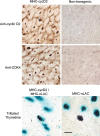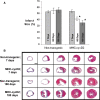Cell-cycle-based strategies to drive myocardial repair
- PMID: 19340478
- PMCID: PMC2691809
- DOI: 10.1007/s00246-009-9408-3
Cell-cycle-based strategies to drive myocardial repair
Abstract
Cardiomyocytes exhibit robust proliferative activity during development. After birth, cardiomyocyte proliferation is markedly reduced. Consequently, regenerative growth in the postnatal heart via cardiomyocyte proliferation (and, by inference, proliferation of stem-cell-derived cardiomyocytes) is limited and often insufficient to affect repair following injury. Here, we review studies wherein cardiomyocyte cell cycle proliferation was induced via targeted expression of cyclin D2 in postnatal hearts. Cyclin D2 expression resulted in a greater than 500-fold increase in cell cycle activity in transgenic mice as compared to their nontransgenic siblings. Induced cell cycle activity resulted in infarct regression and concomitant improvement in cardiac hemodynamics following coronary artery occlusion. These studies support the notion that cell-cycle-based strategies can be exploited to drive myocardial repair following injury.
Figures




Similar articles
-
Cell Cycle-Mediated Cardiac Regeneration in the Mouse Heart.Curr Cardiol Rep. 2019 Sep 16;21(10):131. doi: 10.1007/s11886-019-1206-9. Curr Cardiol Rep. 2019. PMID: 31529165 Free PMC article. Review.
-
Granulocyte colony-stimulating factor treatment plus dipeptidylpeptidase-IV inhibition augments myocardial regeneration in mice expressing cyclin D2 in adult cardiomyocytes.Eur Heart J. 2012 Jan;33(1):129-37. doi: 10.1093/eurheartj/ehr302. Epub 2011 Aug 17. Eur Heart J. 2012. PMID: 21849352 Free PMC article.
-
Cardiomyocyte cell cycle activation improves cardiac function after myocardial infarction.Cardiovasc Res. 2008 Apr 1;78(1):18-25. doi: 10.1093/cvr/cvm101. Epub 2007 Dec 12. Cardiovasc Res. 2008. PMID: 18079102 Free PMC article.
-
Targeted expression of cyclin D2 results in cardiomyocyte DNA synthesis and infarct regression in transgenic mice.Circ Res. 2005 Jan 7;96(1):110-8. doi: 10.1161/01.RES.0000152326.91223.4F. Epub 2004 Dec 2. Circ Res. 2005. PMID: 15576649
-
The cardiomyocyte cell cycle.Novartis Found Symp. 2006;274:196-207; discussion 208-13, 272-6. doi: 10.1002/0470029331.ch12. Novartis Found Symp. 2006. PMID: 17019813 Free PMC article. Review.
Cited by
-
Stress-induced cell-cycle activation in Tip60 haploinsufficient adult cardiomyocytes.PLoS One. 2012;7(2):e31569. doi: 10.1371/journal.pone.0031569. Epub 2012 Feb 14. PLoS One. 2012. PMID: 22348108 Free PMC article.
-
CCND2 Overexpression Enhances the Regenerative Potency of Human Induced Pluripotent Stem Cell-Derived Cardiomyocytes: Remuscularization of Injured Ventricle.Circ Res. 2018 Jan 5;122(1):88-96. doi: 10.1161/CIRCRESAHA.117.311504. Epub 2017 Oct 10. Circ Res. 2018. PMID: 29018036 Free PMC article.
-
Minireview: Won't get fooled again: the nonmetabolic roles of peroxisome proliferator-activated receptors (PPARs) in the heart.Mol Endocrinol. 2010 Jun;24(6):1111-9. doi: 10.1210/me.2009-0374. Epub 2009 Dec 16. Mol Endocrinol. 2010. PMID: 20016041 Free PMC article. Review.
-
Targeted gene therapy for the treatment of heart failure.Can J Cardiol. 2011 May-Jun;27(3):265-83. doi: 10.1016/j.cjca.2011.02.005. Can J Cardiol. 2011. PMID: 21601767 Free PMC article. Review.
-
Potential of cardiac stem/progenitor cells and induced pluripotent stem cells for cardiac repair in ischaemic heart disease.Clin Sci (Lond). 2013 Oct;125(7):319-27. doi: 10.1042/CS20130019. Clin Sci (Lond). 2013. PMID: 23746375 Free PMC article. Review.
References
-
- Bergmann O, Bhardwaj RD, Bernard S, Zdunek S, Barnabé-Heider F, Walsh S, Zupicich J, Kanar Alkass, Buchholz BA, Druid H, Jovinge S, Frisen J (2008) Turnover of human cardiomyocytes. Circulation 118(Suppl):Abstract 3526
-
- {'text': '', 'ref_index': 1, 'ids': [{'type': 'DOI', 'value': '10.1074/jbc.M404975200', 'is_inner': False, 'url': 'https://doi.org/10.1074/jbc.m404975200'}, {'type': 'PubMed', 'value': '15159393', 'is_inner': True, 'url': 'https://pubmed.ncbi.nlm.nih.gov/15159393/'}]}
- Chaudhry HW, Dashoush NH, Tang H, Zhang L, Wang X, Wu EX, Wolgemuth DJ (2004) Cyclin A2 mediates cardiomyocyte mitosis in the postmitotic myocardium. J Biol Chem 279:35858–35866 - PubMed
-
- {'text': '', 'ref_index': 1, 'ids': [{'type': 'DOI', 'value': '10.1016/0092-8674(93)90137-F', 'is_inner': False, 'url': 'https://doi.org/10.1016/0092-8674(93)90137-f'}, {'type': 'PubMed', 'value': '8490963', 'is_inner': True, 'url': 'https://pubmed.ncbi.nlm.nih.gov/8490963/'}]}
- Dowdy SF, Hinds PW, Louie K, Reed SI, Arnold A, Weinberg RA (1993) Physical interaction of the retinoblastoma protein with human D cyclins. Cell 73:499–511 - PubMed
-
- {'text': '', 'ref_index': 1, 'ids': [{'type': 'DOI', 'value': '10.1101/gad.1306705', 'is_inner': False, 'url': 'https://doi.org/10.1101/gad.1306705'}, {'type': 'PMC', 'value': 'PMC1132004', 'is_inner': False, 'url': 'https://pmc.ncbi.nlm.nih.gov/articles/PMC1132004/'}, {'type': 'PubMed', 'value': '15870258', 'is_inner': True, 'url': 'https://pubmed.ncbi.nlm.nih.gov/15870258/'}]}
- Engel FB, Schebesta M, Duong MT, Lu G, Ren S, Madwed JB, Jiang H, Wang Y, Keating MT (2005) p38 MAP kinase inhibition enables proliferation of adult mammalian cardiomyocytes. Genes Dev 19:1175–1187 - PMC - PubMed
-
- {'text': '', 'ref_index': 1, 'ids': [{'type': 'DOI', 'value': '10.1073/pnas.0607382103', 'is_inner': False, 'url': 'https://doi.org/10.1073/pnas.0607382103'}, {'type': 'PMC', 'value': 'PMC1622860', 'is_inner': False, 'url': 'https://pmc.ncbi.nlm.nih.gov/articles/PMC1622860/'}, {'type': 'PubMed', 'value': '17032753', 'is_inner': True, 'url': 'https://pubmed.ncbi.nlm.nih.gov/17032753/'}]}
- Engel FB, Hsieh PC, Lee RT, Keating MT (2006) FGF1/p38 MAP kinase inhibitor therapy induces cardiomyocyte mitosis, reduces scarring, and rescues function after myocardial infarction. Proc Natl Acad Sci USA 103:15546–15551 - PMC - PubMed
MeSH terms
Substances
Grants and funding
LinkOut - more resources
Full Text Sources

